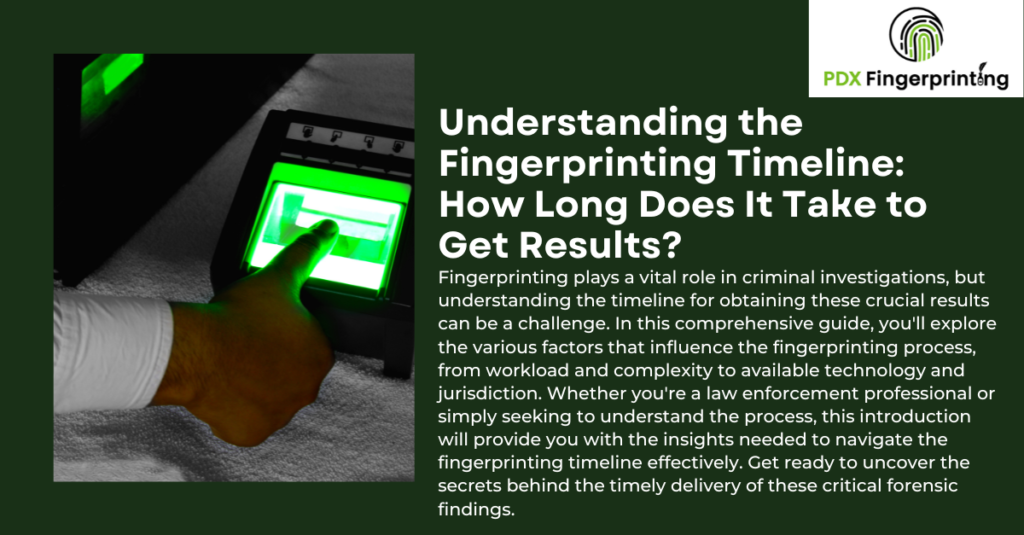
Fingerprinting plays a vital role in criminal investigations, but understanding the timeline for obtaining these crucial results can be a challenge. In this comprehensive guide, you’ll explore the various factors that influence the fingerprinting process, from workload and complexity to available technology and jurisdiction. Whether you’re a law enforcement professional or simply seeking to understand the process, this introduction will provide you with the insights needed to navigate the fingerprinting timeline effectively. Get ready to uncover the secrets behind the timely delivery of these critical forensic findings.
Key Takeaways
- Overview of the Fingerprinting Process: The fingerprinting process involves collection, submission, analysis, verification, and reporting of fingerprint evidence by law enforcement and forensic laboratories.
- Factors Influencing the Timeline: Several factors can impact the fingerprinting timeline, including the workload and caseload of the lab, the complexity of the case, the available technology and equipment, the location and jurisdiction, and the prioritization or urgency of the case.
- Typical Fingerprinting Timelines: For routine cases, the turnaround time can range from a few weeks to several months. Urgent or priority cases may be processed in a few hours to a few days. However, backlogs and delays can result in processing times of several months to a year.
- Strategies for Expediting Results: Strategies for expediting fingerprinting results include prioritizing and escalating time-sensitive cases, utilizing alternative forensic resources, advocating for increased funding and resources for labs, and maintaining regular communication with the investigating authorities.
- Importance of Understanding the Timeline: Understanding the fingerprinting timeline is crucial for law enforcement, the criminal justice system, and the general public, as it can have significant implications for investigations, court proceedings, and personal privacy.
- Flexibility and Collaboration: Navigating the fingerprinting timeline requires patience, flexibility, and a collaborative approach between the relevant authorities and stakeholders to ensure the efficient and effective processing of fingerprint evidence.
The Fingerprinting Process: An Overview
Before delving into the timeline, it’s essential to understand the basic steps involved in the fingerprinting process. Here’s a brief overview:
- Collection: When a crime is committed, law enforcement officers or crime scene investigators collect fingerprints from the scene using specialized techniques and equipment. This may involve dusting for latent prints, lifting impressions, or using advanced imaging technologies.
- Submission: The collected fingerprints are then submitted to a fingerprint analysis laboratory or database, where they undergo further processing and examination.
- Analysis: Fingerprint analysts and examiners carefully compare the collected prints with those stored in databases, such as the Integrated Automated Fingerprint Identification System (IAFIS) or the Next Generation Identification (NGI) system, to search for potential matches.
- Verification: If a potential match is found, the analysts will conduct a thorough verification process to confirm the identity of the individual and ensure the reliability of the fingerprint evidence.
- Reporting: The final step involves the reporting of the fingerprint analysis results, which are then used by law enforcement agencies and the criminal justice system.
Factors Influencing the Fingerprinting Timeline
The time it takes to receive fingerprinting results can vary significantly, depending on several factors. Let’s explore the key elements that can impact the fingerprinting timeline:
1. Workload and Caseload
The workload and caseload of the fingerprint analysis laboratories play a significant role in the timeline. When these facilities are inundated with a high volume of cases, the processing time for individual fingerprints can be longer, as analysts and examiners must prioritize and manage their workload efficiently.
2. Complexity of the Case
The complexity of the fingerprint analysis can also affect the timeline. Cases involving partial or smudged prints, multiple suspects, or the need for additional forensic tests may require more time and resources to process, leading to longer wait times for the final results.
3. Technology and Equipment Availability
The availability and capabilities of the technology and equipment used in the fingerprint analysis process can also impact the timeline. Newer, more advanced technologies and equipment can streamline the process and reduce the time required for analysis, while outdated or limited resources may result in longer processing times.
4. Location and Jurisdiction
The location and jurisdiction of the fingerprint analysis laboratory can also play a role in the timeline. Different states, counties, or even cities may have varying resources, staffing levels, and protocols, which can lead to inconsistencies in the processing times for fingerprinting results.
5. Prioritization and Urgency
In some cases, the urgency or prioritization of a case can influence the timeline. High-profile cases, violent crimes, or situations where public safety is a concern may be given priority, resulting in faster processing times for those specific fingerprinting requests.
Typical Fingerprinting Timelines
Given the various factors that can impact the fingerprinting timeline, it’s challenging to provide a single, definitive timeline. However, we can offer a general overview of the typical timeframes:
- Routine Cases: For routine fingerprint analysis requests, the turnaround time can range from a few weeks to several months, depending on the workload and resources of the laboratory.
- Urgent or Priority Cases: In cases where there is a pressing need for the fingerprinting results, such as active investigations or public safety concerns, the timeline can be significantly shorter, often ranging from a few hours to a few days.
- Backlogs and Delays: In some instances, particularly during periods of high caseloads or resource constraints, the fingerprinting timeline can be significantly longer, with results taking several months or even up to a year to be processed.
It’s important to note that these timelines are general estimates and can vary depending on the specific circumstances and jurisdictions involved. Consulting with the relevant law enforcement agencies or forensic laboratories can provide more accurate and up-to-date information on the typical fingerprinting timelines in your area.
Strategies for Expediting Fingerprinting Results
If the timely processing of fingerprinting results is crucial for your case, there are several strategies you can explore to potentially expedite the process:
- Prioritize and Escalate: If your case is time-sensitive or involves public safety concerns, you may be able to request that it be prioritized by the fingerprint analysis laboratory. This may involve reaching out to the laboratory directly or working with the investigating law enforcement agency to escalate the request.
- Utilize Alternative Resources: In some instances, you may be able to leverage alternative fingerprint analysis resources, such as specialized private forensic laboratories or regional databases, to supplement the work of the primary laboratory and potentially obtain results more quickly.
- Advocate for Increased Funding and Resources: Engaging with policymakers, law enforcement agencies, and the criminal justice system to advocate for increased funding, staffing, and resources for fingerprint analysis laboratories can help improve overall processing times in the long run.
- Stay Informed and Communicate Regularly: Maintaining open communication with the fingerprint analysis laboratory and the investigating law enforcement agency can help you stay informed about the status of your case and any potential delays or developments that may affect the timeline.
Conclusion
Understanding the fingerprinting timeline is crucial for both law enforcement agencies and the general public, as it can have significant implications for criminal investigations, court proceedings, and personal privacy. By exploring the various factors that influence this process, you can gain a deeper appreciation for the complexities involved and the strategies that can be employed to expedite the timely delivery of fingerprinting results.
Remember, the fingerprinting timeline is not a one-size-fits-all scenario, and it’s essential to remain patient, flexible, and proactive in navigating the process. By working collaboratively with the relevant authorities and utilizing available resources, you can ensure that the fingerprinting evidence in your case is processed efficiently and effectively.
FAQ’s
How long does it typically take to get Fingerprinting Results back?
The typical timeline for getting fingerprinting results can vary significantly, ranging from a few weeks to several months, depending on factors such as the workload and caseload of the lab, the complexity of the case, and the available resources. In urgent or priority cases, results may be processed in a few hours to a few days, while backlogs and delays can extend the timeline to several months or even up to a year.
What factors can cause delays in the fingerprinting process?
Delays in the fingerprinting process can be caused by several factors, including high workloads and caseloads at the forensic laboratories, the complexity of the case (e.g., partial or smudged prints, multiple suspects), outdated or limited technology and equipment, and the location and jurisdiction of the lab. Additionally, prioritization of certain cases over others can also contribute to delays in processing times.
How can I expedite the fingerprinting process for my case?
If your case requires timely fingerprinting results, you can explore strategies to expedite the process, such as requesting that your case be prioritized and escalated, utilizing alternative forensic resources, advocating for increased funding and resources for the laboratories, and maintaining regular communication with the investigating authorities to stay informed about the status of your case.
What should I do if I’m experiencing significant delays in getting fingerprinting results?
If you’re experiencing significant delays in the fingerprinting process, it’s important to stay proactive and persistent. First, try to understand the specific reasons for the delay by communicating with the forensic laboratory or the investigating law enforcement agency. If the delay is unacceptable, you may need to escalate the issue by contacting supervisors or policymakers to advocate for more resources and improved processing times.
How can the timeline for fingerprinting results impact criminal investigations and court proceedings?
The timeline for obtaining fingerprinting results can have significant implications for criminal investigations and court proceedings. Delays in the process can hinder the progress of active investigations, potentially compromising public safety or the timely administration of justice. In court, the availability of fingerprint evidence can be crucial for establishing or refuting the involvement of suspects, and delays can impact the overall timeline of legal proceedings.


